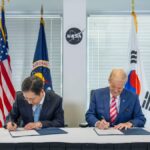In May 2024, an incredible geomagnetic storm, also known as a solar storm, hit Earth, resulting in a vivid aurora that mesmerized observers around the world. These stunning natural displays are created when eruptions of solar plasma, known as coronal mass ejections, collide with Earth’s magnetic field. While these events are a visual delight, they also raise significant questions about the impact of solar radiation on humans traveling outside the Earth’s atmosphere.
Investigating radiation risks in space
During this geomagnetic event, NASA’s BioSentinel spacecraft took the opportunity to collect crucial data on solar radiation. This research is vital as NASA prepares for future missions to the Moon and Mars. As noted by Sergio Santa Maria, who leads the BioSentinel project at NASA’s Ames Research Center, the timing coincided with solar maximum, allowing for an in-depth examination of the radiation environment in space.
BioSentinel’s unique mission
BioSentinel, a compact satellite about the size of a cereal box, is over 30 million miles from Earth in solar orbit. Unlike life on Earth, which is protected by the planet’s magnetic field, the BioSentinel had to withstand the full impact of the solar storm. Initial data suggest that while the storm was significant, it was associated with only a moderate increase in solar radiation, indicating that the immediate threats to life may not be as severe as previously expected.
Adaptation of scientific goals
Originally intended to study yeast in space, BioSentinel has shifted its focus to understanding the broader implications of deep space conditions. The spacecraft’s biosensor instruments continue to provide valuable insights into the radiation environment in space. Santa Maria noted that despite the completion of the biological aspect of the mission, BioSentinel still has significant scientific importance, demonstrating its capability for future long-duration missions.
Conclusion: Importance of ongoing research
The spectacular aurora borealis that illuminate the night sky serve as a reminder of the unseen forces that govern our solar system. As NASA and its collaborators strive to deepen our understanding of space environments, data collected by missions like BioSentinel are crucial. This research not only advances our knowledge of solar radiation, but also informs the safety and success of future human exploration beyond Earth.


